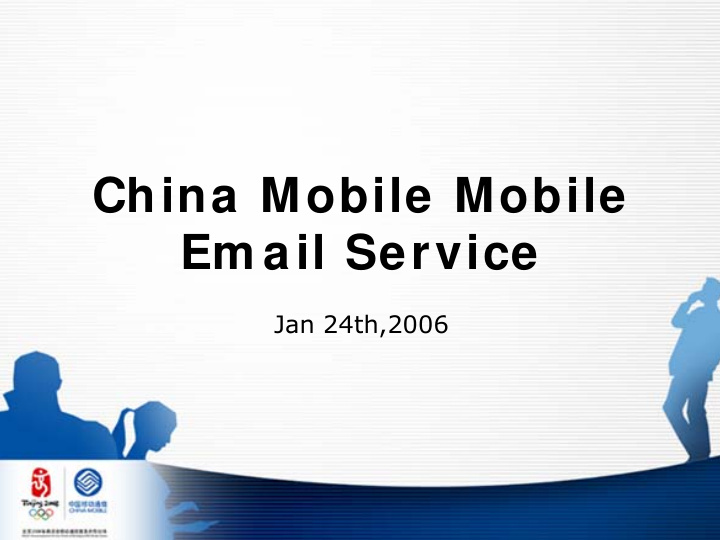



China Mobile Mobile Em ail Service Jan 24th,2006
Outline ▪ Market in China ▪ Service Requirements ▪ Business Model ▪ Expectation
the Trend - Mobile Em ail Mobile Email meets new requirements: Mobility, Safety, Real time Wireless Wireless Mobile Email CONVERGENCE CONVERGENCE Computing Internet Computing Internet
Market in China ▪ Mobile Email market data : –Email amount : 20/day/person –Email size : 4 ~ 20K –Email receive time (based on GPRS) : 10s –Read Attachment on mobile terminals : <10% Enterprise Mass ▪ Mobile Email forecast –Enterprise market 50000 1200000 –Mass market 1000000 40000 800000 30000 600000 20000 400000 10000 200000 0 0 2005- 2006 2006- 2007 2007- 2008
Outline ▪ Market in China ▪ Service Requirements ▪ Business Model ▪ Expectation
Mobile Em ail vs. Em ail Email Mobile Email Terminal High performance Low performance Enough Storage Limited Storage Network Reliable Intermittent High speed Low speed Low cost High cost Security Easy to deploy Not ready Model Pull & Poll Pull & Poll The requirement for push is eager
Requirem ents for MEM ▪ OMA MEM RD has defined integrated use cases and requirements for mobile email service ▪ IETF Lemonade IMAP Profile 1&2 will meet the requirements of OMA MEM RD ▪ OMA MEM RD is accorded with our service plan
Minim um Requirem ents for CMCC ▪ Push: pull and poll models are not recommended in wireless environment ▪ Attachment Handling: – Only download attributes of an attachment, e.g. filename, size, etc. – Only download selected attachments – Attachment format transcoding ▪ Compression ▪ Server-side forwarding ▪ Secure transfer ▪ No needs to modify existing firewall settings ▪ Independent of PIM service
Outline ▪ Market in China ▪ Service Requirements ▪ Business Model ▪ Expectation
Value Chain of MEM Service ▪ Carrier: Network provider, Charging, mobile enabler Carrier ▪ Solution provider ▪ Device vendor: provide terminals supporting mobile Enterprise/ Solution email SP m ailbox provider ▪ User: pay for mobile email service ▪ Enterprise/SP mailbox: Device User enhance their mail services Vendor through cooperation with carriers
Business Model A Operator Mailbox Mobile email Mobile Internet Network Proxy GSN TCP/IP/HTTP Value Chain Proxy owned and managed by SP Solution provider leads the business because of the NOC, solution platform and branding ownership.
Business Model B Operator Enterprise Mobile email Proxy Push Mail GW + Mobile Internet Network mail server GSN Value Chain Proxy owned and managed by enterprise Enterprise controls the whole project because of the buy side position.
Business Model C Operator Mailbox Mobile email Mobile Internet Network Proxy Mail GW GSN TCP/IP/HTTP Value Chain Proxy owned and managed by carrier Carrier leads the business because of the NOC ownership and standard definition.
Pros and Cons for Operator Pros Cons Model A ▪ Service / support can outsourced to ▪ Service provided by third party (no third party branding) ▪ Benefit from the traffic fee ▪ Shared revenue / licenses ▪ Limited control over service quality ▪ First line for customer complaints ▪ Security is TBD and must be carefully reviewed Model B ▪ Increased traffic without needing ▪ No service branding operator investment ▪ Limited control over service quality ▪ Can build relationship / packages with ▪ Segmental market enterprise ▪ Bit pipe Model C ▪ Unified service branding ▪ Need enterprise sales channels to offer service ▪ Maintain customer relationship ▪ Can provide more services ▪ No additional licenses ▪ Security controlled by operator ▪ Service quality controlled by operator
Preferred Business Model ▪ Service Providing – Operator provide platform and service supported by partner ▪ Business Supporting – Operator provide the customer service and support – Partner provide background service and support. ▪ Business Charging – Operator set up the tariff system and charge the service ▪ Marketing expansion – Operator cooperate with all partners to develop the whole market.
Outline ▪ Market in China ▪ Service Requirements ▪ Business Model ▪ Expectation
Accelerate standardization w ork ▪ International standard body defines open standard as soon as possible ▪ Device vendor build-in standard conformance native push email client in their mobile device ▪ Deploy solution ASAP in the meanwhile based on open specifications with clients that can be OTA upgrade to follow the standard once stable
Thank You
Recommend
More recommend